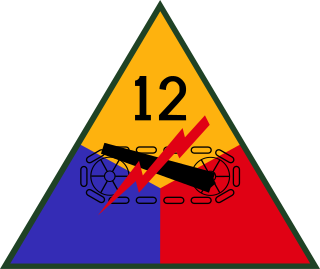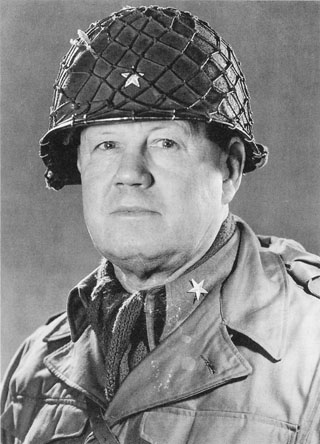
The 36th Infantry Division ("Arrowhead") also known as the "Panther Division", the "Lone Star Division", "The Texas Army", and the "T-patchers", is an infantry division of the U.S. Army and part of the Texas Army National Guard. The 36th Infantry Division was organized during World War I (1914–1918) from units of the Texas National Guard and of the Oklahoma National Guard. As an all-Texas unit, the Arrowhead Division was called to service for World War II (1937–1945) on 25 November 1940, was deployed to the European Theater of Operations in April 1943, and returned to the Texas Army National Guard in December 1945.

The 1st Infantry Division (1ID) is a combined arms division of the United States Army, and is the oldest continuously serving division in the Regular Army. It has seen continuous service since its organization in 1917 during World War I. It was officially nicknamed "The Big Red One" after its shoulder patch and is also nicknamed "The Fighting First." The division has also received troop monikers of "The Big Dead One" and "The Bloody First" as puns on the respective officially sanctioned nicknames. It is currently based at Fort Riley, Kansas.

The 4th Infantry Division is a division of the United States Army based at Fort Carson, Colorado. It is composed of a division headquarters battalion, three brigade combat teams, a combat aviation brigade, a division sustainment brigade, and a division artillery.

The 12th Armored Division was an armored division of the United States Army in World War II. It fought in the European Theater of Operations in France, Germany and Austria, between November 1944 and May 1945.

The 14th Armored Division was an armored division of the United States Army assigned to the Seventh Army of the Sixth Army Group during World War II. It remains on the permanent roll of the Regular Army as an inactive division, and is eligible for reactivation. The division is officially nicknamed the "Liberators".

The 20th Armored Division was an armored division of the United States Army that fought in World War II. It was activated on 15 March 1943 at Camp Campbell in Kentucky.

The 42nd Infantry Division (42ID) ("Rainbow") is a division of the United States Army National Guard. The 42nd Infantry Division has served in World War I, World War II and the Global War on Terrorism (GWOT). The division is currently headquartered at the Glenmore Road Armory in Troy, New York.

The 38th Infantry Division is an infantry division of the United States Army and part of the Indiana National Guard. It is headquartered in Indianapolis, Indiana, and contains Army National Guard units from across the Midwest.

During the Dachau liberation reprisals, German SS troops were killed by U.S. soldiers and concentration camp prisoners at the Dachau concentration camp on April 29, 1945, during World War II. It is unclear how many SS guards were killed in the incident, but most estimates place the number killed at around 35–50. In the days before the camp's liberation, SS guards at the camp had forced 7,000 inmates on a death march that resulted in the death of many from exposure and shooting. When Allied soldiers liberated Dachau, they were variously shocked, horrified, disturbed, and angered at finding the massed corpses of prisoners, and by the combativeness of some of the remaining guards who allegedly fired on them.

The New York Army National Guard is a component of the New York National Guard and the Army National Guard. Nationwide, the Army National Guard comprises approximately one half of the United States Army's available combat forces and approximately one third of its support organization. National coordination of various state National Guard units are maintained through the National Guard Bureau.

Felix Laurence Sparks was an American attorney, government official, and military officer from Colorado. A veteran of World War II, he attained the rank of brigadier general in the Colorado Army National Guard and received the Silver Star and the Purple Heart. Sparks also served as District Attorney of Colorado's 7th Judicial District, an Associate Justice of the Colorado Supreme Court, and the longtime director of the Colorado Water Conservation Board.

The 26th Infantry Division was an infantry division of the United States Army. A major formation of the Massachusetts Army National Guard, it was based in Boston, Massachusetts for most of its history. Today, the division's heritage is carried on by the 26th Maneuver Enhancement Brigade.
The 150th Field Artillery Regiment is a field artillery unit in the Indiana Army National Guard.

The 168th Infantry Regiment is an infantry regiment of the United States Army. The 1st Battalion of the 168th Infantry is part of the 2nd Infantry Brigade Combat Team, 34th Infantry Division, part of the Iowa National Guard.

The 56th Stryker Brigade Combat Team (SBCT), 28th Infantry Division, also known as the Independence Brigade, is a brigade combat team of the Pennsylvania Army National Guard and has its headquarters located at Horsham Air Guard Station in Willow Grove, Pennsylvania.

Brigadier General Henning Linden was a United States Army officer who served in World War II. He was notable for his role in the liberation of the Dachau concentration camp while serving as assistant division commander (ADC) of the 42nd Infantry Division.
The Combat Aviation Brigade, 42nd Infantry Division is a subordinate command of the 42nd Infantry Division. Once contained solely within New York, force reductions and reorganizations have resulted in units from several different states making up the brigade.

The 107th Field Artillery Regiment is a Field Artillery Branch regiment of the United States Army. It has been affiliated with the Pennsylvania National Guard since its formation. It appears that the regiment last formally came into existence in June 1959, when the 107th Field Artillery Battalion was reorganized as the new Regiment's 1st Battalion in line with the Pentomic (ROCID) reorganization going on at that time.

The 222nd Infantry Regiment was an infantry regiment of the United States Army, AUS. It served in the 42nd Infantry Division for the duration of the Second World War, and was then deactivated. The regiment distinguished itself in battle against the Wehrmacht and earned the Presidential Unit Citation for courageous action.

The 232nd Infantry Regiment was an infantry regiment of the United States Army during World War II. It served in combat with the 42nd Infantry Division, the "Rainbow Division", and served during the Occupation of Germany before its deactivation in 1947.

















